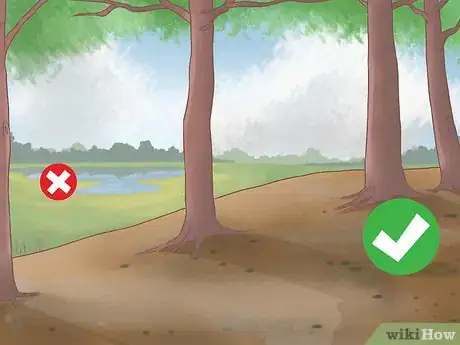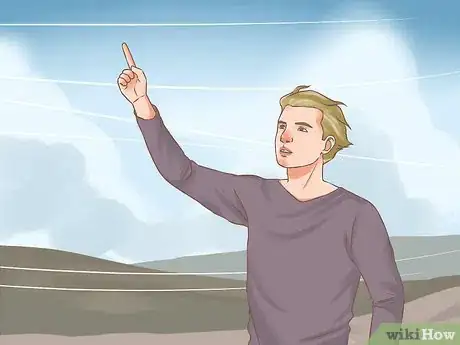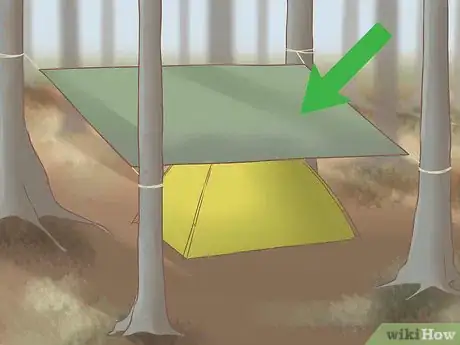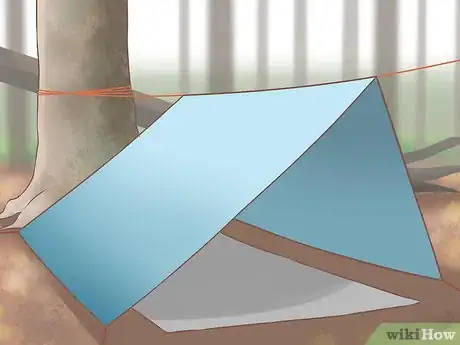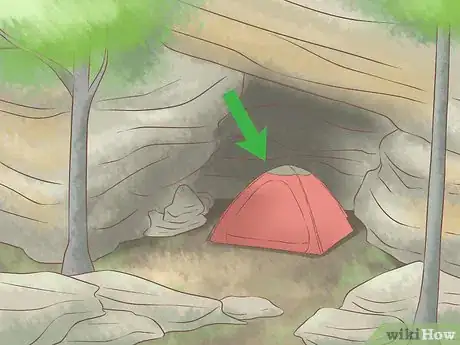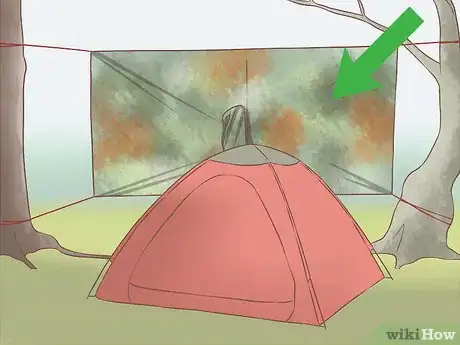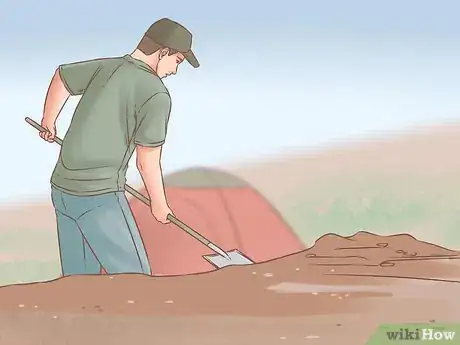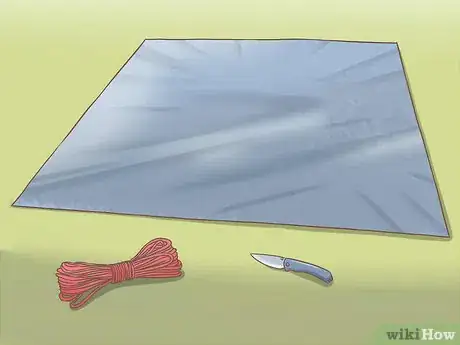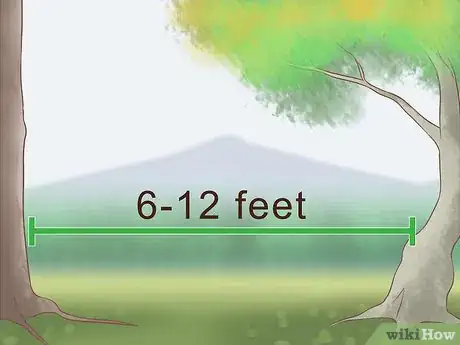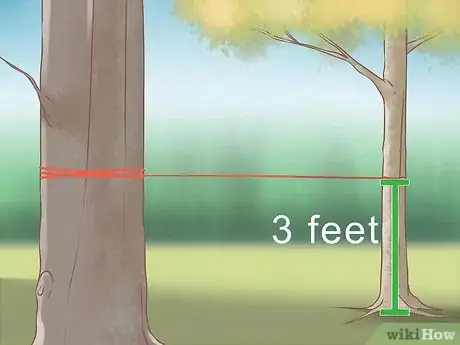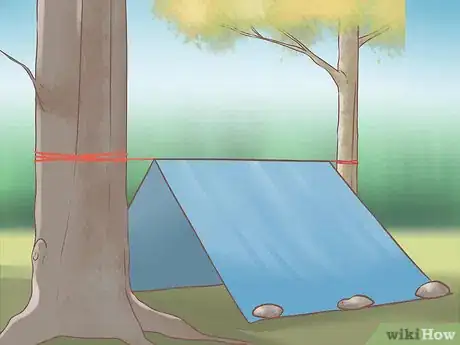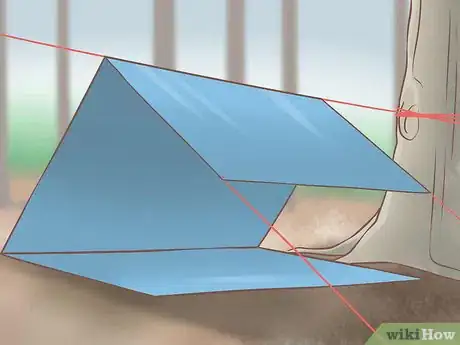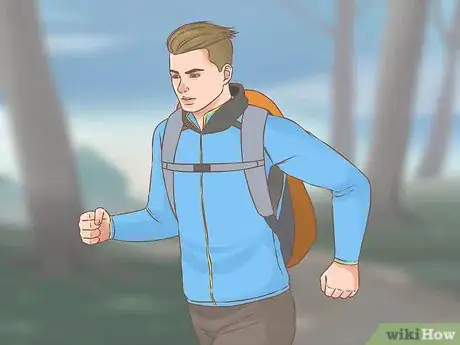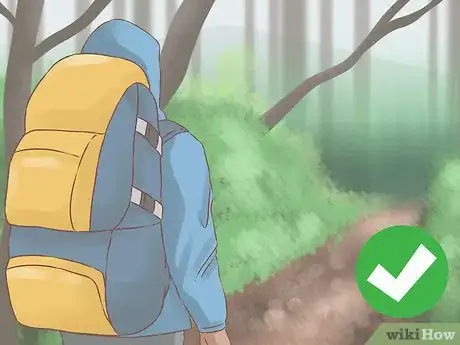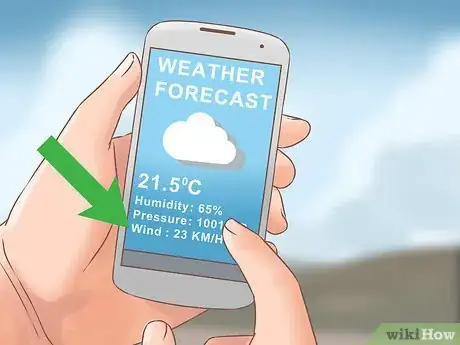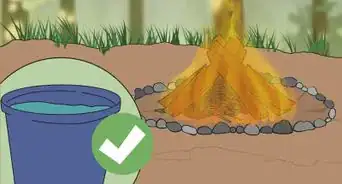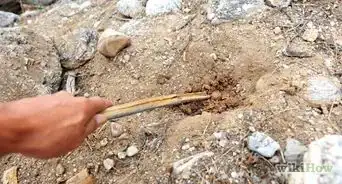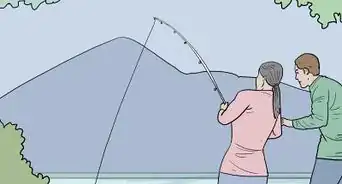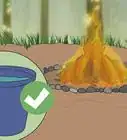This article was co-authored by Josh Goldbach. Josh Goldbach is an Outdoor Education Expert and the Executive Director of Bold Earth Adventures. Bold Earth leads adventure travel camps for teenagers all over the world. With almost 15 years of experience, Josh specializes in outdoor adventure trips for teens both in the United States and internationally. Josh earned his B.A. in Psychology from Eckerd College in St. Petersburg, Florida. He’s also trained as a wilderness first responder, a Leave No Trace master educator, and a Level 5 Swiftwater rescue technician.
This article has been viewed 35,350 times.
Many hikers and campers are aware of the dangers of cold, heat, and extreme weather, but forget to take wind into account in their emergency plans. Wind carries heat away from your body in cold weather, accelerates dehydration, and may affect breathing or visibility by stirring up dust or snow. Whenever you are forced to make an emergency campsite, look for a spot protected from the wind, if at all possible.
Steps
Weather-Wise Camping
-
1Select Sheltered Campsites. If high winds are in the forecast, pick campsites that offer shelter, if possible. Avoid wide-open spaces. Better selections include:
- Groves of trees. The trunks of trees will help break the wind naturally.
- Rock faces. Wind typically comes from one main direction. If you can find a cliff or rock outcropping that blocks the wind, you will be much better off.
-
2Check for localized geography. You may assume that because it is windy where you are now, it is equally windy every way. Taking a little time to explore the local area--if possible--may reveal it is less windy in a different area. This can greatly reduce the amount of work needed to block the wind at your chosen camp. For example:
- Winds may be stronger near a large body of water, such as an ocean or lake.
- Valleys, passes, gulches, and the like may form "wind tunnels" in which winds are intensified from a certain direction.
Improvising a Wind Barrier at Your Campsite
-
1Tie down a tarp to block wind from one direction. If your campsite is protected against wind on most sides, fill the gap with a tarp. Tie the tarp to trees or structures at a 45º angle to the ground, in front of your tent or campfire.
- This may be dangerous in high-wind situations, as tarps may suddenly rip out tent stakes, poles, and so on and could be damaged.
- In high-wind situation, you are better off blocking off the smallest possible area well than try to create a large wind-block. For example, blocking off enough area so that the camp stove will work properly is better than trying to set up a 10'x10' tarp to its full area to do the same task.
-
2Construct a tarp shelter. If caught in an exposed area where the wind comes from multiple directions, you'll need a shelter you can hunker down inside. Try making an A-frame tarp shelter as emergency cover, or to reinforce your tent's wind-breaking ability, as described here.
-
3Build a natural wall. This will typically be made of rocks or scrub. Look for a rocky area with the materials to build your own small wall to lie behind at night. Find scrub, fallen branches, and anything handy to make a barrier. Ideally, you can find a sheltered area between boulders.
- It all depends on the environment, but there are other natural wind blocks that you can look for, such as deviations in terrain, depending on which way the wind is blowing.
-
4Hang up a poncho or jacket. As a last resort, string up the largest wind-proof clothing you have between two trees. These are thinner and smaller than tarps, but they will help a little, and may prevent your fire from being extinguished by the wind.
-
5Dig in. Another approach is to find a depression in the terrain, or dig one. Lie or stay in this area with a tarp or other protection over you.
Building an Emergency Windbreak
-
1Pack shelter supplies. Even if you're just on a day hike with no camping gear, be prepared to construct a shelter in case of an emergency. As long as the area has a few trees or stout bushes, all you need are these three items:
- A lightweight groundsheet made of rip-stop nylon. A ground cloth for a large tent is a good choice, as they are typically made from ripstop nylon coated with waterproof PVC.
- A 50 ft. (15 m) coil of ⅛ in. (3 mm) parachute cord (paracord), to serve as a strong, lightweight rope.
- A small pocketknife to cut the paracord.
-
2Choose two trees or other structures. Find a spot protected on as many sides as possible from the wind. Look for two trees about 6–12 feet (1.8–3.7m) apart on the windward side, forming a line wind's path.
- Make sure there are no dead branches above the spot you've chosen to shelter. Strong wind may cause these to fall.
-
3String the paracord tightly between the trees. Tie a length of paracord securely to each tree, about three feet (0.9 m) off the ground. This will be the top of the "wall" you create with your groundsheet. If you have cord to spare, stretch a second length of it just above the ground to support the bottom edge of the groundsheet as well.
-
4Drape the groundsheet over the cord. Weigh down the groundsheet with fist-sized rocks or any heavy objects. Alternatively, tie the corners of the groundsheet to the horizontal cord with additional paracord.
- You can use trekking poles, ski poles, or even the skis themselves to support additional support for your windbreak.
-
5Form a roof or floor if possible. If you're caught in rainy weather, position part of the groundsheet on a slope and tie it to another length of cord to form a roof. If the ground is wet, use part of the ground sheet underneath you to keep you dry.
- With a particularly large groundsheet, you can even improvise a pup tent, stretching each corner taut with another length of paracord. Weigh down the edge of the groundsheet with rocks.
Protecting From Wind while Hiking
-
1Wear a windbreaker in cold weather. Wear a thin, windproof outer layer to reduce wind chill in cold weather. This should be made from a lightweight material, breathable enough to minimize trapped sweat. Ideally, your windbreak layer should include trousers as well as a hooded jacket.
-
2Maximize hiking time through sheltered areas. The less time you spend on ridges and in exposed, windy areas, the better. Walk through sheltered areas such as forests when possible. If you're on an overnight hike, look for a rock shelter before sunset.
- Wind is usually much more extreme on one side of a mountain or tall hill. Walk along the lee side instead.
-
3Take wind into account when making plans. If weather forecasts predict high winds, understand the risks involved before you go hiking. Windblown snow can reduce visibility to extremely short distances, obscure the trail, or block your access entirely with large drifts. In the desert, wind can whip up dust and irritate your eyes and lungs. If you are not prepared to deal with these conditions, you may need to shorten your hike or cancel it entirely.
Expert Q&A
-
QuestionHow do you make a natural windbreak?
 Josh GoldbachJosh Goldbach is an Outdoor Education Expert and the Executive Director of Bold Earth Adventures. Bold Earth leads adventure travel camps for teenagers all over the world. With almost 15 years of experience, Josh specializes in outdoor adventure trips for teens both in the United States and internationally. Josh earned his B.A. in Psychology from Eckerd College in St. Petersburg, Florida. He’s also trained as a wilderness first responder, a Leave No Trace master educator, and a Level 5 Swiftwater rescue technician.
Josh GoldbachJosh Goldbach is an Outdoor Education Expert and the Executive Director of Bold Earth Adventures. Bold Earth leads adventure travel camps for teenagers all over the world. With almost 15 years of experience, Josh specializes in outdoor adventure trips for teens both in the United States and internationally. Josh earned his B.A. in Psychology from Eckerd College in St. Petersburg, Florida. He’s also trained as a wilderness first responder, a Leave No Trace master educator, and a Level 5 Swiftwater rescue technician.
Outdoor Education Expert Rocks can be a good tool—just make sure that the land management agency allows it. Look for medium-sized rocks that are big enough to make a difference but aren't difficult (or painful) to carry. Then, stack the rocks in a wall formation (or a U-shaped formation).
Rocks can be a good tool—just make sure that the land management agency allows it. Look for medium-sized rocks that are big enough to make a difference but aren't difficult (or painful) to carry. Then, stack the rocks in a wall formation (or a U-shaped formation).
Expert Interview

Thanks for reading our article! If you’d like to learn more about camping, check out our in-depth interview with Josh Goldbach.
Warnings
- In severe windstorms, watch for dead branches or leaning trees which the wind may bring down.⧼thumbs_response⧽
